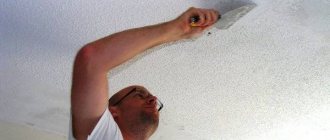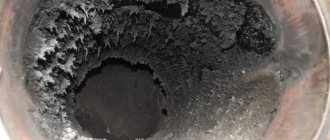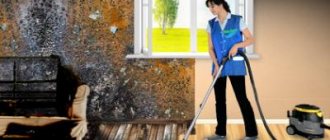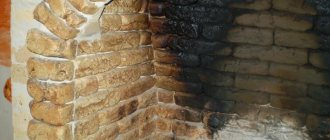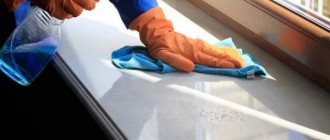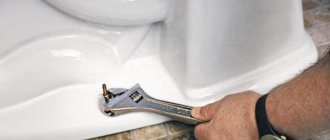Ways to quickly wash away soot or soot so that it becomes really clean are of interest to many. The fact is that the composition of this substance is such that fatty impurities and resin can be found in it.
Ways to quickly wash away soot or soot so that it becomes really clean are of interest to many
Soot is a product of combustion of various materials. Another name for it is soot. It is not heavy in itself and easily penetrates into any nooks and crannies. If you decide to wash dirty places with a damp cloth, you will regret it very much. After all, this way you may never get rid of traces of soot. The soot will change its structure, fill existing microcracks, and it will be extremely difficult to wash it off.
Cleaning should be carried out in several stages:
- Dry cleaning.
- Wet cleaning.
- Final processing.
Soot is a product of combustion of various materials.
Its other name is soot. It is necessary to choose a product for cleaning soot based on how severe the contamination is and how long ago the soot formed. In any case, before carrying out any work, you must protect yourself. It is not recommended to breathe in soot, so use a respirator or gauze bandage to protect your respiratory system. You can put a scarf over your hair. A thin hat will also do. Wear things that you can throw away later. And don't forget rubber gloves. If you need to wash away soot after a fire, then be prepared to resort to aggressive methods.
First stage of cleaning
You should start by removing as much of the settled layer as possible. For such purposes, you may need a vacuum cleaner. With its help, soot is removed from surfaces. The floor must first be cleaned. Then lay an oilcloth on it. You can get rid of soot by using a broom. Only all movements should be performed lightly so as not to smear it.
To clean soot from glass and polished items, you will need a dry cloth. Just don’t rub it, but throw it to one side. The most important thing in this process is not to grind the soot. You must collect it and shake it off and do not allow it to come into contact with moisture.
Once you have gotten rid of the bulk of the soot, you can move on to wet cleaning.
It is necessary to choose a product for cleaning soot based on how severe the contamination is and how long ago the soot formed
Features of cleaning soot from different surfaces
Metal
Soot is often observed in chimneys, fireplaces, boilers, and cauldrons due to constant interaction with combustion products. Before washing soot off metal, it is important to familiarize yourself with the range of chemical solutions offered on the market and choose the least aggressive product. Sometimes a mechanical method is used, but due to the duration, inconvenience of cleaning and close contact with soot, it is not recommended to use it.
We recommend:
How to clean a stone countertop from stubborn dirt and stains in the kitchen
Plastic
For cleaning, use a sponge soaked in a cleaning solution. Plaque on the surface of the plastic should be scrubbed off slowly and thoroughly. Dishwashing detergent, washing powder, laundry soap are available means for cleaning plastic, which should be used before you start washing off soot using specialized solutions. Finally, rinse off any remaining product with clean water until stains and odors are removed.
How to remove soot from a tree
Soot penetrates deeply into the wood thanks to numerous pores; the cleaning process for treated and untreated wood is different. The untreated one is cleaned with a small amount of water and a special product for a short period of time, in order to avoid swelling and destruction of the structure. Treated wood additionally requires care and caution to avoid damaging the paint or varnish. To speed up the drying process, use fans.
Note! The structure of wood does not allow for complete washing of wooden furniture: soot particles settle deeply in pores inaccessible to solutions. It is recommended to replace the structure, furniture or, in extreme cases, paint them.
Other
It is recommended to wash the glass surface with a glass cleaner, removing the bulk of the plaque in advance with a soap solution. To clean walls and wallpaper, use a sponge soaked in concentrate.
Today there is a wide range of chemicals and methods for successfully cleaning various surfaces from soot deposits. It is important to clearly understand how you can dissolve soot quickly and effectively in order to quickly save your family and friends from the effects of the carcinogen on health.
1/5 — (3 votes)
Rinsing process
The main product used to remove soot is a degreaser and dish gel. You will need a thick lint cloth and sponges. Take a container and fill it with warm water. Detergent is also added there. The remaining dirt must be removed by sweeping movements. The rag or sponge should be constantly rinsed or replaced with a clean one. The water should also change. These factors directly affect the quality of cleaning.
A gel-like product designed for cleaning the house will be very effective in cleaning dirt. In particular, you can use preparations that are designed to remove plaque from the sink or toilet. They are used to wet the area where carbon deposits are present. Just be careful. After all, many chemicals contain acids that can cause harm, discolor or lead to deformation of the surface that is being cleaned.
On sale you can find a special sponge that is soaked in detergent. Such products are called melamine.
The product should be selected based on the material of the surface intended for cleaning. For example, if you have to clean a plastic window or ceiling, you will need a chemical solvent, gasoline or alcohol. You will need to wet a sponge with one of the solutions listed and get rid of the dirt. At the end, everything must be washed with detergent.
You should start by removing as much of the deposited soot layer as possible.
A plastic window can be washed with a glass cleaner that contains alcohol. To clean plastic skirting boards, use a paste (soda plus detergent). The paste must be used if the contamination is really serious.
READ ALSO: How to clean a bathtub
You can use bleach to get rid of old stains. But before starting work, test its effect on a small area of dirty surface. This is important because the chemical may cause the surface to change color.
In addition, you can try to remove old stains using vinegar, soda or hydrochloric acid. If you perform work using these substances, you must ventilate the room. Be sure to provide eye and hand protection.
A plastic window can be washed with a glass cleaner that contains alcohol.
Properties and composition
Soot is a product of incomplete combustion of fossil fuels. The main component of plaque is black carbon, fat residues. Due to its high adhesive properties, soot easily settles on exhaust pipes, stove pipes, chimneys, furniture and interior decoration after a fire. Soot can consist of different chemical elements, depending on the type of product being burned. The term "carbon black" is erroneously used to refer to carbon black, which is produced on an industrial scale under certain conditions and a specific chemical composition.
Soot particles entering the lungs accumulate over time in the respiratory system, which leads to the development of bronchitis and pneumonia. Chronic exposure to soot elements on the body causes mutations in cells and increases the risk of the growth of malignant tumors. Soot also easily penetrates the bloodstream, in which the toxic compounds formed disrupt the functioning of many organs. For this reason, heart attack, stroke, asthma and premature death occur, so it is necessary to figure out how to effectively wash off soot deposits in order to eliminate further particles from entering the body.
The final stage
After you have treated all the walls, windows, ceiling and floor, you need to go through it again with warm, clean water and wipe everything dry. You will need paper to rub the window glass, and treat the rest of the surface with cleaning wipes.
The fire, or rather its remnants, will remain in the air for a long time. Therefore, the room must be ventilated. To get rid of unpleasant odors, you can use an air ionizer. Alternatively, place a towel soaked in a weak solution of table vinegar in the room.
If there are places where it was not possible to wash off the soot, then be prepared to carry out unscheduled minor cosmetic repairs. All you have to do is prime the surface and apply a finishing material.
Today you can find many chemicals on sale that can remove soot and soot from any surface. But when using them, you must adhere to safety precautions.
Removal products
Today there is a wide variety of substances and methods that can be used to wash soot from any surfaces or materials effectively and quickly. Folk and specialized remedies, mechanical and chemical effects - all this is aimed at successfully combating soot deposits at home.
Note! Before washing off soot, you must carefully read the instructions for the substances used or follow all safety measures aimed at protecting the skin and mucous membranes from aggressive solutions.
Inventory
Mechanical action is the simplest way to easily clean soot without using special solutions. To work, you will need a gentle mechanical brush with metal bristles or a regular scraper. It is important to use tools with a handle extension feature to increase the maximum permissible pipe cleaning area.
Special means
There are many different chemical solutions against soot on the market, thanks to which it is possible to effectively and quickly clean any surface. The main active ingredient in these products is a highly concentrated alkali, which instantly destroys soot deposits.
Scientists recommend using special solutions that:
- safe for humans;
- remove unpleasant odors;
- quickly clean;
- can be used on any materials without loss of effectiveness.
Folk remedies
The use of table salt as a way to clean or prevent the formation of soot in chimneys is widely used at home. Before heating, you need to put a couple of tablespoons of salt in the firewood. The method is ineffective because it can only remove a small amount of plaque.
Potatoes are another popular folk remedy for cleaning chimneys. The starch released into the pipe interacts with soot and causes plaque decomposition. The method is ineffective with massive deposits, but can prevent the formation of soot in pipes for a short time.
Main recommendations
An important rule is to never use water or abrasive devices to clean wood walls. Immediately exclude such aids as:
- bleach or other chlorine-containing preparations;
- water;
- abrasive sponges;
- metal brushes;
- liquid soap;
- cleaning powders;
- sprayers;
- Karchers and steam cleaners.
Cleaning soot from the ceiling in a bathhouse Source alfaclean.by
Using a mechanical method to clean soot and deposits in a bathhouse Source remontnik.ru
When cleaning a bathhouse, be sure to follow safety rules and wear items of clothing that make contact with chemicals safe. These items include:
- working headdress (cap, headscarf, scarf);
- latex gloves;
- plastic buckets, basins (metal may oxidize);
- petal respirator (a four-layer gauze bandage is also suitable);
- robe;
- protective glasses.
When using special cleaning products for wood, be sure to read the instructions. Otherwise, you may harm the wood partitions.
Petal brush for cleaning wooden walls in a bathhouse Source ecosrub.ru
Application of vinegar essence
It is necessary to dilute the product with water in a ratio of 1: 2, then thoroughly mix the two components, then apply the prepared product to the soft side of the sponge. Afterwards, all that remains is to wipe the contaminated surfaces with the composition until streaks appear, then rinse the sponge and reapply the diluted essence. This should be done until the soot completely disappears from the surface. Then you need to wipe it with a damp cloth.
On a note! If the soot layer is thick enough, then the vinegar is not diluted, but used in its pure form.
Causes of soot and soot
Smoke with soot appears due to the low combustion temperature in the furnace or an improperly organized traction system. In such cases, when the boiler door is opened, clouds of smoke will come out and be absorbed by the walls. There are a number of other reasons why soot accumulates:
- The chimney pipe becomes overgrown with soot or a foreign object gets inside, making it difficult to remove the soot.
- Errors in the construction of heating equipment. Incorrect slopes, incorrect location of the smoke exhaust duct and the design of the stove itself can cause soot to appear. Only a thorough modification of the sauna heating will correct the situation.
- Strong wind. If the weather is bad outside, the wind can blow into the chimney. This will cause smoke to escape in the opposite direction. In this case, soot on the walls is inevitable. Some designs include a ridge, but often if the wind direction is unfavorable, it is absolutely useless.
- The appearance of cracks in brickwork. New holes begin to draw air out of the oven from all sides. This causes smoke to escape from the firebox. Even if you manage to ventilate the room, soot will still fall on the surface of the wooden walls.
- Smoke. If, after a long break, the firebox is not preheated, then smoke penetration into the room is inevitable. To prevent this, before starting the kindling, throw a few newspapers or a rag doused with gasoline inside, then set it on fire.
Single-story baths are a common practice; accordingly, the smoke exhaust system will be located lower. Therefore, bad weather and other factors that prevent normal air circulation inside the stove will cause smoke inside the room.
Cleaning walls in a bathhouse with ammonia diluted with water Source dizainvfoto.ru
What you need before cleaning
Regardless of what surface the soot has settled on, you must:
- change into old clothes that you don’t mind;
- wear a respirator, rubber gloves and preferably goggles;
- remove curtains and carpets;
- remove furniture from the room that is not affected by soot;
- take everything outside for airing.
You also need to try to wipe off the soot with old rags, vacuum, sweep. A significant portion of the soot is removed, making further cleaning of surfaces less difficult.
We recommend
DOCKER MAZBIT PLUS is a concentrated product for cleaning surfaces from the effects of fire. Designed for effective quick cleaning of any surfaces (wood, concrete, plaster, stone, tiles) from various contaminations by combustion products, such as soot, soot, carbon deposits. Without smell. Does not contain chlorine or acid.
More details
How to clean soot from walls after a fire How to wash soot off a tree
Clean up soot after fires
Fire or smoke leads to damage to property, loss of human life and health, and other irreparable consequences. Afterwards, the room is covered with black spots and filled with a burning smell. Even carrying out repair work does not always solve this problem. This can be done if you act correctly, from garbage collection to air freshening.
Important! Do not try to remove soot using a damp cloth or soft sponge soaked in clean water. Thus, the contamination will only increase in size and cannot be removed.
Garbage collection
The first step in soot removal is removing debris. All unusable damaged objects must be removed from the premises: furniture, books, remnants of clothing, etc. If the walls have managed to smoke, then the finishing material must be carefully removed from them with a spatula.
We will also have to say goodbye to those objects that were not damaged by the fire. These include wooden furniture, windows, doors and decor. They have the ability to quickly absorb odors, so even after all soot stains have been removed, a burning smell may continue to be present in the room. Before you take them to the trash, you need to try to eliminate the odor by taking them out into the fresh air or treating them with a special solution.
Dry processing
After removing the debris, you can begin dry cleaning the affected areas. This requires several steps:
- Cover the flooring with film.
- Using a spatula, remove the finishing coating from the walls.
- Use a vacuum cleaner or stiff brush to remove soot from the ceiling and walls.
- Remove soot from corners or cracks.
- Remove dirt from the floor.
Garbage collection and dry processing boils down to the removal of all objects that contain a burning smell or soot from the room. After this, it will be easier to clean the walls after a fire with special compounds.
Wet processing
When carrying out wet cleaning to remove carbon deposits, you need to use a folk remedy (soda or soap solution), a professional kit or a ready-made product. They need to carefully remove soot from the ceiling, then continue wet cleaning from top to bottom. After completing this action, it is recommended to additionally treat each surface with a primer to level the damaged walls.
Air purification
Another important step in eliminating traces of a fire is air purification. For this purpose, it is recommended to use special disinfectants or an ozonizer that helps instantly eliminate carbon compounds. To do this, just turn on the device and in a few days it will completely eliminate the unpleasant odor from all surfaces and objects.
If there is no ozonizer and a special disinfectant, then you can try to eliminate the unpleasant aroma using the folk method. It is simpler, less expensive, but also less effective. To implement it, you need to pour water into a deep saucepan with a dense bottom and boil the liquid for several hours. Thus, the air will be saturated with hot moisture, and under the influence of steam, the burning smell will disappear.
Important! Of course, for a single air purification you do not need to buy an expensive ozonizer. Currently, in every city there are cleaning services where you can rent this equipment.
How to wash soot off hands
Start with the first method. If it doesn't work, move on to the second one.
What you will need
- Any soap, including liquid, baby or laundry soap.
- Warm water.
- Bath washcloth.
What to do
Wash your hands thoroughly with warm water and soap. For minor stains this may be sufficient. If there are stains on the skin here and there, try scrubbing them off with a washcloth.
What you will need
- Baking soda or facial scrub.
- Warm water.
- Any soap.
- A couple of lemon slices (optional).
- Moisturizing hand cream.
What to do
Wet your hands in warm water, and then wash them with baking soda or scrub - just as you would use liquid soap.
To remove traces of soot around your nails, thoroughly rub your fingertips with a lemon wedge. Then wash your hands in warm soapy water and pat dry with a towel.
After the procedure, apply moisturizing hand cream. This is necessary to protect the skin from drying out after quite aggressive cleansing.
Preparatory work before cleaning
Regardless of which method you want to use to remove soot from a bathhouse, you must first prepare.
- Clear the room of unnecessary items (towels, soap, various hygiene products).
- Wear protective clothing: be sure to wear gloves, a respirator, and goggles (choose special plastic ones with good transparency).
- Cover clean surfaces with polyethylene or any film to prevent dust and dirt from getting into these places.
- Take a broom and a hard-bristled brush and clean the top layer of dirt. Also remove all cobwebs and small debris from the coverings.
- After completing the steps, you can proceed to the main type of processing: mechanical or chemical method.
Elastic melamine sponge for removing soot from wooden walls in a bathhouse Source khoz-byt.rf
We suggest studying the list of expected materials and tools that will be required for the mechanical removal method:
- a long-handled brush-brush is suitable for removing dirt from crevices and corners;
- a sharp knife or knitting needles will help remove soot in hard-to-reach places: between logs, behind the stove;
- sandpaper with a fine degree of abrasiveness (it will help to carefully remove too fine dry soot without damaging the wood);
- A melamine sponge is suitable if there are small and non-permanent stains on the walls. This device acts like an eraser.
Please note that you can use folk remedies to clean soot from wooden walls. For example, crushed red brick. Its crumbs are rubbed onto walls in areas of contamination. This promotes removal. The spray can be applied to a dry cloth or sponge.
Brick chips for cleaning walls from soot in a bathhouse Source tennisitpro.rf
Ecology DIRECTORY
Soot and soot flying out of factory chimneys and polluting the air of industrial cities contain carcinogenic substances (benzopyrene, etc.), which, willy-nilly, many people have to inhale in doses that are sometimes dangerous, predisposing them to cancer. Chemical plants emit tons of highly dispersed chemically active dust and gases into the air. Until now, despite the enormous progress of technology, heavy dark gray caps of toxic aerosols hang over large industrial cities, over the capitals of world powers - over London, Paris, New York, etc., and neither hygienists nor technicians accept emergency measures for a merciless fight against this everyday evil.[...]
In 1963, a thick fog of soot and smoke (smog) descended on New York City, leading to the death of more than 400 people.[...]
Examination of this window revealed traces of soot about 1 cm long, although the window itself was not damaged [588]. A charred portion of the wood frame and a small area of softened window putty were found, indicating a possible point of contact. Soot-like traces left by ball lightning were reported earlier [1900].[...]
Maximum permissible concentrations of soot (soot): maximum one-time 0.15 mg/m3, average daily 0.05 mg/m3. [...]
Industrial emissions, exhaust gases, soot, soot, dust in the air of large cities form a kind of smoke hoods and weaken the penetration of the ultraviolet part of the solar spectrum. For example, in the vicinity of Paris, where there are no industrial enterprises, ultraviolet rays account for about 3% of radiation, in areas with factories and factories - 0.3%. Lack of ultraviolet rays leads to the development of rickets and vitamin deficiency in children.[...]
| Venturi scrubber for removing dust, steam, soot and submicron particles from gases |
The atmosphere of many industrial centers is polluted with dust, smoke, soot, sulfur and nitrogen oxides, hydrocarbons, carbon monoxide, lead and many other harmful substances. These pollutants cause bronchitis, lung cancer, emphysema and other diseases.[...]
In Germany, about 2 million tons of dust and soot settle on the surface of the earth every year, while 500 thousand tons of sulfur dioxide enter the atmosphere. Every day, New York alone spews 4 thousand tons of carbon monoxide, more than 3 thousand tons of sulfur dioxide and about 300 tons of industrial dust into the air. Emissions of harmful substances into the atmosphere by the Uralvagonzavod production association in Nizhny Tagil alone amount to 18.6 thousand tons per year. In Paris, due to increasing atmospheric pollution, the duration of sunshine has decreased by 25% over the past 40 years; Mortality from lung cancer has doubled over the past 10 years.[...]
Sewage, industrial waste, waste, smoke, exhaust gases, dust, soot - all this poses a threat to our existence. We have read and continue to read about this in many messages, where, using specific examples, they try to prove that our society, which has completely lost all connection with nature, itself creates obstacles to its further development due to the continuously growing amount of all kinds of waste. According to such prophets, it is not the shortage of consumer goods, but the increase in the amount of waste that will someday pose a serious threat to human existence. As arguments, they mainly cite the increasing pollution of water bodies, large accumulations of garbage dumps, the occurrence of smog (a continuous, fog-detained veil of smoke gases emitted by factory chimneys, cars, etc., which, under certain weather conditions in industrial areas, can cause mass diseases, in some cases even fatal) and other phenomena that pose a danger to humans. However, with these hypotheses the situation is approximately the same as with the hypotheses of supporters of the teachings of Malthus, who argued that epidemics, wars and other disasters are inevitable consequences of the fact that the world population is growing faster than the production of means of subsistence, and therefore are their own kind of a law of nature. However, these views are untenable, because they underestimate the creative abilities of man, his desire to understand more and more deeply the laws of development of nature and society, in order, on the basis of these laws, to transform the world around him, forcing it to serve for the benefit of man.[...]
Spark plugs have the following main faults: contamination with soot and oil, burnt electrodes, cracks in the insulator. Candles must be periodically cleaned from carbon deposits with an alkaline solution or using a special sandblasting machine. Repaired spark plugs are checked for sparking and tightness of connections using special devices M-514-2 and others according to technical specifications. [...]
During restoration, stone buildings and monuments come first! It is cleaned of dust and soot, then immediately or as work progresses, coatings are applied from high-molecular materials - silicones, which prevent access to water, but are gas-permeable. [...]
In other industrialized countries, the amount of waste is generally comparable to the data given for the United States. Modern production has sufficient technological capabilities to solve emerging problems, but the planning and organization of production of equipment for collecting unwanted waste lags far behind existing needs, mainly due to economic considerations. [...]
In Fig. 1 provides data relating to 1925-1926 on the daily change in the concentration of soot particles in the air of the city of Rochdale (England) on weekdays and Sundays. The figure shows that the maximum soot occurs on weekdays from 8 a.m. to 4 p.m. and the soot content in the air at this time is twice the same values for night hours.[...]
A third pollutant that reduces visibility is smoke. It consists of small particles of soot and ash that enter the atmosphere during various combustion processes. Often smoke is in the air at the same time as haze or fog.[...]
Note: when the soil is waterlogged, the root collar rots. In the city you should protect from dust and soot.[...]
Some hazardous substances are found in particulate matter. Sometimes they contain carbon (for example, in the form of soot), which adsorbs carcinogenic (cancer-causing) substances. Settling in the bronchi, they can eventually cause lung cancer. When autopsying the corpses of people who inhale smoky air, it is discovered that the alveoli of the lungs are covered with a black layer of soot.[...]
HMs enter the environment with emissions from energy, industrial and transport enterprises in the form of aerosols, dust and soot, as part of solutions and suspensions of industrial waste, with solid industrial waste, as well as with mineral dyes, household appliances and other goods.[...]
On the morning of October 26, 1948, thick fog - smog - enveloped the city of Donora (Pennsylvania, USA). Soot began to fall from the mixture of fog with smoke and soot, covering houses, sidewalks and pavements with a black blanket. For two days, visibility was so bad that residents had difficulty finding their way home. Soon, doctors were besieged by coughing and choking patients who complained of shortness of breath, runny nose, sore eyes, sore throat and nausea. Over the next four days, until heavy rain began, 5,910 people out of the city's 14,000 residents fell ill. Twenty people died. Many dogs, cats and birds died.[...]
But after that, some influential bankers and industrialists finally decided to wipe their eyes, dusted with soot from their own factories, and look into the future. It was clear that Pittsburgh was going downhill and things needed to change. A conference of all interested groups was convened to discuss the problems of city planning from all points of view. In 1945, a long-term plan was developed to build urban structures and purify the air over the city. This was followed by extensive measures to renovate buildings and install smoke eliminators.[...]
As defined in this instruction, an air pollutant is a change in the natural composition of the air, especially smoke, soot, dust, gases, aerosols, vapors, including water or odorous substances. [...]
To make an artificial standard scale on drawing paper, use a mixture of red ink with watercolor paints “lamp soot” and “green zinc” to accurately imitate the color of natural standard stains corresponding to the content of 0; 0.05; 0.1; 0.2; 0.5; 0.8; 1; 2 tsg gpO.[...]
Gas is sucked through the flow line into the sample preparation system; The cleaning filter prevents the entry of large particles of dust and soot. Through the connecting pipeline, the gas enters the moisture separator, which is a volume in which condensate accumulates and is periodically drained. From the moisture separator, the gas enters the flow stimulator through a fine fiber filter and a control filter, then into the working chamber of the optical absorption sensor and is discharged through the outlet fitting. [...]
Aspen has two important properties: it absorbs the composition against smoldering matches well and, due to the absence of resinous substances, does not produce soot. Unfortunately, a major biological disadvantage of aspen is the exceptional tendency of tree stands to suffer from heart rot disease. Therefore, it is difficult to overestimate the importance of work aimed at finding a set of measures for growing healthy aspen.[...]
In previous chapters we examined some of the properties of particles suspended in atmospheric air. Among them, the most famous are droplets of water, particles of soot, grains of sand and particles of sea salt. In this section we will focus on the properties of those particles that most people know much less about. [...]
To determine the amount of solid matter emitted into the atmosphere by the pipes of oil refineries, power plants and other sources of dust and soot, sampling vessels are located downwind of the source of pollution and left for a fairly long period of time (usually about a month). Sampling vessels are inexpensive, so many of them can be installed at once. At the end of the specified period, the amount of sediment obtained is determined by careful weighing. Having received the necessary data, it is possible, for example, to determine the effectiveness of a smoke eliminator on a factory chimney. The method of sampling vessels is widely used by many organizations dealing with issues of industrial air pollution, including the sanitary inspection of the Federal Health Service. [...]
Edward I (1239-1307) was the English king from 1272. A special law prohibited the heating of London houses with coal, because... the city was choking in the stench of coal soot.[...]
When heating greenhouses with stoves, if the chimneys malfunction, the leaves burn, caused by smoke and the harmful substances it contains. The settling of soot and soot on plants causes the formation of plaque, with a significant layer of which a disruption of photosynthesis and assimilation occurs.[...]
A glowing (smoking) flame is produced when there is insufficient flow of air oxygen into the burner, which leads to incomplete combustion of gas and the release of carbon. Hence the soot; light is a consequence of the incandescence of carbon particles in a flame. Colorless flame is oxidizing; luminous - restorative (takes away oxygen).[...]
Harmful substances, being waste from technological processes, are in the air with impurities of flue gases, ventilation emissions in the form of dust, toxic gases, soot, products of incomplete combustion of fuel, vapors, aerosols, which are carried by air currents into water and soil.[...]
Among existing types of fuel, methane occupies one of the first places. The advantages of this ideal combustion product are expressed in the completeness of combustion, the absence of slag, soot and soot, which is very important for the environment. At treatment plants, the combustion of methane gas in the furnaces of the boiler room is widely used to heat mainly digesters and premises located on the territory of the station. No special equipment is required for this. Gas from digesters in its natural raw form (without purification and drying) enters the furnace of the boiler with a gas burner. [...]
Among existing types of fuel, methane occupies one of the first places. The advantages of this ideal combustion product are expressed in the completeness of combustion, the absence of slag, soot and soot, the absence of fuel delivery costs, ease of storage, ease of maintenance, and ease of combustion control. [...]
This group includes diseases caused by unfavorable climatic and soil conditions, mechanical damage and the action of toxic gases, smoke, soot and dust contained in the air, especially in cities and factory towns. When exposed to these factors, the formation of spots and plaques on leaves and shoots, drying of leaves and needles, wilting and death of seedlings and annual shoots, dying and drying out of shoots and tree tops, bark burns, and the formation of wounds on trunks and branches are observed.[...]
As already noted, the air of large cities contains a huge number of pseudoaeroions of positive polarity. These are particles of tar dust, smoke, soot, soot, acid oxides and other aerosols charged with positive electricity - products of incomplete combustion and chemical waste from factories. Numerous observations have established that the farther you are from factories and other industries, the less harmful aerosols of positive polarity the air contains. This fact is well illustrated by the aerial ion map of Leningrad, where this issue was studied in detail in the pre-war years. The fight against high concentrations of positive particles in large cities in the light of data on the harmful effects of positive air ions on the body is of particular importance. The author theoretically and experimentally developed a plan for local artificial saturation of urban air with negative air ions. The air of city squares and parks can be aeroionized by installing special fountains. Fountains, finely spraying water, create the Lenard effect, electrifying the bipolar environment. To obtain unipolar negative air ions in the air surrounding the fountains, it is necessary to equip the fountain nozzles with electrical equipment that will contribute to the appearance of an overwhelming concentration of negative air ions in the air. The area of operation of such special fountains can be quite large and will provide the necessary concentrations of negative air ions in the surrounding air. The latter neutralize harmful aerosols of positive polarity and deposit them down, thereby partially neutralizing the air. The scope of such an electric fountain will be a kind of electric resort inside a modern city. The finest crushing and atomization of water with the simultaneous supply of electric potential to the spray nozzle makes it possible to obtain a spherical volume of air with a radius of up to 10-15 m, saturated with air ions of negative polarity. [...]
The group of heavy air ions gradually turns into a group of super-heavy ones, which are called aerosols - particles uncharged or charged with electricity of one sign or another. They consist of soot, smoke, dust, fog, small raindrops, snowflakes, etc. Such particles can carry a large number of elementary electrical charges on their surface and not carry a single true gas ion.[...]
Dust containing silicic acid can cause lung diseases - silicosis, which in such a situation can develop into an occupational disease. The presence of dust, smoke, soot and toxic substances in the air of residential areas pollutes the air of residential premises, clothing, makes it difficult to clean premises and dry clothes, deprives the population of the opportunity to ventilate premises, and worsens sanitary and hygienic living conditions. Contamination of the surface of the glass with dust and soot reduces the illumination of the premises, and a significant part of the ultraviolet radiation is lost. The smallest particles of dust and gases serve as nuclei for the condensation of water vapor, increasing the amount of precipitation, cloudy days, and fog, which adversely affects the health of the population in industrial areas. [...]
Of interest are the data obtained at the lamp factory in the area where the bases are poured. The number of positive particles turned out to be 6117 and the number of negative ones - 7594 per 1 cm3, the unipolarity coefficient was 0.82. The presence of smoke and soot suggests the presence of a large number of pseudoions and the rapid disappearance of the lungs. [...]
Probably the most notorious smog area in the world is Los Angeles. There are plenty of chimneys in this city. In addition, there is a huge number of cars. Together with these generous suppliers of smoke and soot are both elements of smog formation that played such an important role in Donora: temperature inversions and the mountainous nature of the terrain. [...]
There are three types of surfaces: those exposed to active runoff during precipitation (white, the surface consists of recrystallized calcite and gypsum in small quantities), gray (moderate exposure to water flows, covered with a thin layer of soot and a thin layer of gypsum), black (in recesses have a uniform layer 1-10 mm thick of gypsum and calcite with a large percentage of dispersed soot).[...]
Carcasses intended for long-term storage are smoked for 2-3 days with cold smoke, the temperature of which is about 20°C. For short-term storage, it is better to smoke carcasses with hot smoke at a temperature of 80°C in the first hour of smoking, and 35-40°C for the rest of the time. Smoking lasts 3-4 hours. After smoking, the carcasses are wiped with a dry cloth to remove soot and carbon deposits. They are stored in a suspended state in a cool, dry room at a temperature not exceeding 5°C. [...]
The effect of sulfur dioxide on the respiratory system is enhanced in the presence of water vapor (fog) and smoke, obviously due to the fact that the main part of gaseous 502 dissolves in the moisture of the mucous membranes of the mouth and nose and in the form of an aerosol can penetrate into the internal respiratory organs, where it is converted into sulfuric acid - a transformation that, in the presence of water, soot and ash, partially occurs in an aerosol state. As is known (see page 13), air pollution 302, especially during prolonged fogs, causes exacerbation of diseases of the upper respiratory tract, which can lead to a significant increase in mortality. However, as the example of London has shown in recent years, the reduction of smoke emissions alone through improved home heating systems (without a simultaneous reduction in EO emissions) has led to a noticeable reduction in the number of upper respiratory tract diseases.[...]
The main component of this system is an installation for burning waste in a fluidized bed at a temperature of 730 C. The exhaust flue gases of this installation are cleaned in a scrubber irrigated with water before being released into the atmosphere and practically do not contain soot or any foul-smelling impurities. [...]
Polluted, dusty air significantly shortens the service life of city buildings: additional costs for their repairs annually amount to hundreds of millions of rubles. The same can be said about industry. For example, the ash emitted by enterprises is not so harmless for them. It contributes to accelerated abrasive wear of moving parts of equipment and the formation of rust. Dust and soot are no less contraindicated in agriculture: in the conditions of Donbass, with heavy dust and gas pollution and as crops approach sources of emissions, grain yields are reduced by an average of 20%.[...]
One of the ways to effectively combat air pollution in populated areas is to take into account the characteristics of the meteorological regime. There are many examples of irrational choice of location for the construction of industrial facilities due to ignorance or ignorance of the meteorological conditions of the area. It is obvious that industrial facilities should be located on the leeward side in relation to residential buildings, so that combustion products, harmful gases, soot and dust, emitted even in small doses, are carried by prevailing winds not towards densely populated areas of the city and its forest park zone, but in a relatively free space. It is impossible to build air-polluting enterprises in valleys and depressions, where, especially in the winter months, with weak winds and calm conditions, a surface temperature inversion is almost constantly observed, manifested in an increase in air temperature with height instead of its usual decrease for the troposphere. During inversions, factory emissions concentrate locally and create harmful conditions for people and the entire biosphere. Errors of this kind when choosing a site for the construction of an enterprise, as well as placing buildings and structures on it, designers can avoid by working closely with meteorologists and climatologists.[...]
Oxides of sulfur, nitrogen, chlorine, hydrogen fluoride, hydrogen sulfide and ammonia, in addition to direct toxic effects, are also participants in various reactions in the atmosphere, leading to the formation of secondary products, sometimes even more toxic. Sulfur dioxide, which is formed in large quantities when burning sulfur fuels (coal, fuel oil, gas), in a humid atmosphere easily turns into sulfuric acid - the main active ingredient of acid rain. The effect of the latter is also enhanced by nitrogen oxides, which, in addition to being converted into nitrous and nitric acid, participate, together with gasoline vapors and fuel soot, in the formation of toxic photochemical oxidants and toxic smog.[...]
During the extraction and processing of oil, natural gas, condensate, and especially with the widespread use of various products obtained from them, a significant amount of various pollutants is released into the environment. In addition to the ones mentioned, the pollutants also contain mercaptans IH, which are part of natural gas, vapors of methanol CH3OH, used as an inhibitor, diethylene glycol C4H3(OH)g and ammonia IH3, used for drying gas and neutralizing sulfur, as well as waste water, dust, sludge, soot, etc. [...]
How to remove soot from clothes
Soot stains remain on clothing after cleaning up the aftermath of a fire or for other reasons. Unlike other surfaces, soot is easier to wash off from fabric. It is enough to soak the product in a soapy solution. The washing machine will remove any residue. It is recommended to use high temperature. Bleach is used to restore the product to its original appearance.
Specialized means
It is recommended to focus on choosing household chemicals. You can remove soot stains from clothes using products containing fat-soluble substances.
First you need to soak the item in a soapy solution, then wash it in a machine. If the method turns out to be ineffective, you can use a professional stain remover. They use powdered Vanish, a spray from Amway. After treatment, it is recommended to rinse the clothes manually or in a machine.
You can remove stains from clothes using a Faberlic stain remover pencil.
You should moisten the stained area with water, rub with a pencil until foam appears, wait 30 minutes and wash the product in the usual way. You can remove soot from white items using bleaches, which quickly eliminate the problem. It is necessary to soak the item for 10 minutes in the prepared solution, observing the proportions: 2 caps per 5 liters of cold water. Tulle curtains and other delicate light-colored fabrics are not recommended to be washed off soot in this way; the structure of the material is damaged.
When purchasing a product, read the composition. You need to take into account the color of the linen: white, black. Read the instructions carefully before the procedure. Follow the rules to avoid damage.
Substances at hand
There are also folk methods for removing black soot deposits left on your favorite T-shirt. You can prepare your own cleaning mixture, the components of which do not affect the color or structure of the material. Would need:
- In a bowl, combine baking soda, dishwashing liquid and vinegar. The ingredients are added in equal proportions: 1 teaspoon each.
- Once the reaction begins, you need to apply the mixture to the soot stain to wash the item.
- Leave for 15 minutes to enhance the effect, then rinse and machine wash.
It is dangerous to wash fabrics that require careful handling in this way; it is recommended to use a solution of turpentine and raw eggs. Take turpentine and lightly beaten yolk in equal proportions, combine the components, rub the liquid into the soot stain and leave for 20 minutes. To eliminate the characteristic aroma of the substance, rinse the item in a vinegar solution and wash it in a machine.
Pure turpentine, purified gasoline, kerosene and solvent can wash away old marks on thick fabrics - jeans, cotton.
To remove soot from a work jacket, simply treat the area with liquid and wait 20 minutes. Rinse in a vinegar solution to eliminate pronounced odor, and wash the item in the usual way.
If soot has settled on the carpet or upholstery, you can wash it using the above methods. In addition to pigment, soot contains fats. First, degrease the stain with gasoline, then treat it with turpentine. You can wash off the residue with warm water.
Prevention of soot and soot in the steam room
The most important condition for maintaining cleanliness in the bathhouse is maintaining the proper operation of the traction system. To do this, the following list of measures is taken:
- sealing cracks in a brick kiln immediately after they appear.
- internal cleaning of chimneys from layers of soot.
- firebox with chimney-sweep logs: aspen firewood, potato peelings.
- Regular removal of ash from the ash pit.
- cleaning all surfaces in a bath with soda solution several times a year.
Who cares about soot?
First of all, soot on a metal surface creates a coating that makes it difficult to see rust, cracks and other flaws that need to be eliminated.
Smoky metal surfaces give the impression of an uncleaned, abandoned room. An unpleasant burning smell appears in the house.
Soot has an oily base, so it can stain your hands and clothes near the stove. Then you will have to wash your hands and wash your clothes for a long time.
For a real owner, the question of how to clean soot from metal becomes a matter of honor.
